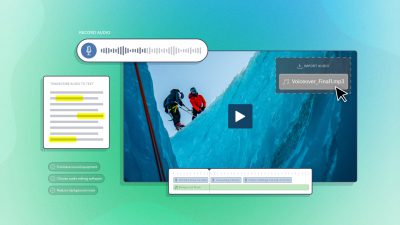Monetizing your video content is a very popular business idea that works well in a variety of industries – not just entertainment. For instance, you can include paid video content as part of an online course, for consulting, or for personal training.
Here are the important steps to take for video security and marketing to make sure you’re building a sustainable business.
Protect Your Videos
It’s likely you are planning to sell your videos either as your main product, or as part of a service package. Your videos probably represent a significant investment for you or your business. After all, paid content tends to be high production value.
Since they’re key to your business and very valuable, you need to protect your videos from being misappropriated. Usually, that means preventing them from being downloaded or shared without permission.
This can be achieved in several different ways. However, the core idea is the same: to control access to your videos; and track your viewers closely.
Take Care of the Basics
Select a video hosting provider that takes video privacy very seriously. Look for a service that is geared towards business video, and which offers robust video privacy features.
For instance, SproutVideo offers secure streaming, disables downloads by default, and has a suite of video privacy tools for different use-cases.
If you pick the right video hosting provider from the start, you’ll only have to worry about getting your settings right and making sales. Your video hosting platform will take care of the rest.
Where to Share Online
Next, determine where you’ll be publishing your videos. It could be your existing website on WordPress, Squarespace, Wix or any other website hosting platform. It could even be a totally custom website you coded yourself.
In this scenario, you’ll be copying and pasting your video embed code to your website. In all likelihood, you’ll want to publish your videos in a secure, “customers-only” area of your website.
Another option is to use the landing pages or video website built into SproutVideo’s hosting platform. Your videos will automatically appear on your website according to their privacy settings, so you don’t have to touch any code to set one up.
Limit Where Your Videos Appear
Once you’ve decided where to share your videos, make sure they can’t be found anywhere else on the web.
If you’re embedding your videos on your website, you need to safeguard your embed code. A savvy web-user could potentially find the embed code on the page, and share it on another website.
To prevent that from happening, you can use allowed domains or signed embed codes. Both of these video security tools prevent your embed codes from working on websites other than the ones you specify. That means that even if someone manages to locate your video embed code, it won’t work on any website other than your own.
If you’re using SproutVideo’s website solution, use allowed domains to keep your video embed codes safe.
Control Viewer Access to Your Videos
Limiting access to your videos is the best way to keep your content safe because it reduces the chances your content could fall into the wrong hands. In order to control access to your videos, you need to be able to determine who is allowed to watch them using video privacy settings. You may even want to go further, and limit viewer access to a specific window of time, or number of viewing sessions.
Instead of displaying all of your premium content publicly, you’ll likely want to share it in a protected area of your website. Usually, customers can only access these pages of your website after they make a purchase. Or, if they purchased a subscription for a period of time, after logging into their account.
The best way to set that up depends on how you’re sharing your videos. Here, we have guides to controlling viewer access with different platforms and tools. Don’t see your platform or tool listed? Get expert guidance in the comments below.
Your Custom Website
Most website hosting providers have solutions for processing payments, or managing subscription memberships. Look to your specific website hosting provider for guidance on the best solution for your business.
If you go this route, be sure to leave your videos set to Private on the SproutVideo platform. This means your videos will only be accessible where they are embedded.
With SproutVideo Websites
If you’re using SproutVideo’s landing pages or websites, you have a variety of built-in privacy settings to choose from. However, login protection is particularly well-suited for paid content for several reasons.
Login protection allows you to control viewer access at a very granular level. You can use this setting to grant video access to individuals, and set their access to expire after a period of time or number of uses.
Even better, using login protection, you can allow certain users to download your content, while still preventing others from doing so. You can revoke one viewer’s access without impacting any other viewers. This flexibility works well for many paid content models.
Other options that could potentially work for paid video content include password protection for videos or password protection for video websites. Leave a comment below if you’re unsure of which option might be best for your business, and we’ll be happy to help you out.
Tracking Viewers
Once your videos are being shared securely, don’t you want to know exactly who is accessing them? Tracking viewers is the best way to make sure your content remains secure on an ongoing basis. It can also help your business in other ways as well.
SproutVideo offers several options for tracking viewers using their email address. There are options available regardless of whether you are embedding your videos or using the video websites or landing pages we provide.
Once you’ve passed your viewers’ email addresses to our platform, you’ll see their email appear next to their viewing sessions, which are tracked in your video engagement metrics. These powerful metrics will tell you exactly who watched your videos, and how much they rewatched or skipped. It will also indicate their location, IP address, and device.
Using this data, you can verify that only paid customers are accessing your content. If you notice suspicious viewing patterns, such as someone watching from multiple different locations in short periods of time, you can reach out to that viewer or revoke their video access.
Wait, How Do I Get Those Viewers Again?
Before you can track viewers, you need to attract them. You’ll need to advertise your high value video content, and what better way to do it than with, you guessed it, more video! Make short, snappy videos from your existing footage that highlight your main value proposition, and limit them to 30 seconds max.
Limiting it to 30 seconds is an excellent rule of thumb to follow to avoid giving away too much. If you cannot fit it in 30 seconds, you probably need a more visual presentation of your ideas, and less text or audio.
Once you have your marketing videos, you have several options for promoting them. You can share them on social media with your existing fans and followers. If you need more reach, use promoted video posts on Facebook or Instagram to reach new audiences.
Link your ads back to a signup form on a landing page, or an email-gated video to capture valuable lead information. You can also use post-play screens for your call-to-action.
Once you have contact information for leads, use email marketing to nudge them towards a sale. Using one of the marketing platform integrations SproutVideo offers, send those leads straight to the list of your choice. You can then automate these email campaigns even further, using more video to drive engagement at each stage.
If you are curious about other ways you can promote your paid video content, ask us in the comments below!
Have you implemented any of these tips? We would love to learn from your experience. Let us know about it in the comments below!








